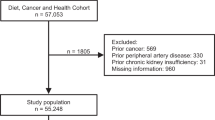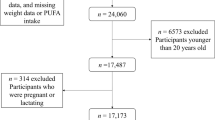Abstract
Background/Objectives:
Marine ω-3 fatty acids have beneficial effects on cardiovascular risk factors. Consumption of fatty fish and marine ω-3 has been associated with lower rates of cardiovascular diseases. We examined the association of fatty fish and marine ω-3 with heart failure (HF) in a population of middle-aged and older women.
Subjects/Methods:
Participants in the Swedish Mammography Cohort aged 48–83 years completed 96-item food-frequency questionnaires. Women without any history of HF, myocardial infarction or diabetes at baseline (n=36 234) were followed from 1 January 1998 until 31 December 2006 for HF hospitalization or mortality through Swedish inpatient and cause-of-death registers; 651 women experienced HF events. Cox proportional hazards models accounting for age and other confounders were used to calculate incidence rate ratios (RR) and 95% confidence intervals (CI).
Results:
Compared with women who did not eat fatty fish, RR were 0.86 (95% CI: 0.67, 1.10) for <1 serving per week, 0.80 (95% CI: 0.63, 1.01) for 1 serving per week, 0.70 (95% CI: 0.53, 0.94) for 2 servings per week and 0.91 (95% CI: 0.59, 1.40) for ⩾3 servings per week (Ptrend=0.049). RR across quintiles of marine ω-3 fatty acids were 1 (reference), 0.85 (95% CI: 0.67, 1.07), 0.79 (95% CI: 0.61, 1.02), 0.83 (95% CI 0.65, 1.06) and 0.75 (95% CI: 0.58, 0.96) (Ptrend=0.04).
Conclusion:
Moderate consumption of fatty fish (1–2 servings per week) and marine ω-3 fatty acids were associated with a lower rate of first HF hospitalization or death in this population.
This is a preview of subscription content, access via your institution
Access options
Subscribe to this journal
Receive 12 print issues and online access
$259.00 per year
only $21.58 per issue
Buy this article
- Purchase on Springer Link
- Instant access to full article PDF
Prices may be subject to local taxes which are calculated during checkout

Similar content being viewed by others
References
Bays H (2006). Clinical overview of Omacor: a concentrated formulation of omega-3 polyunsaturated fatty acids. Am J Cardiol 98, 71i–76i.
Becker W, Darnerud PO, Petersson-Grawé K (2007). Risks and Benefits of Fish Consumption. Livsmedelsverket/National Food Administration: Sweden Internet: http://www.slv.se/default.aspx?id=231&epslanguage=EN-GB (accessed 27 May 2008).
Bergström L, Kylberg E, Hagman U, Erikson H, Bruce (1991). The food composition database KOST: the National Administration's information system for nutritive values of food. Vår Föda 43, 439–447.
Brouwer IA, Zock PL, Camm AJ, Bocker D, Hauer RN, Wever EF et al. (2006). Effect of fish oil on ventricular tachyarrhythmia and death in patients with implantable cardioverter defibrillators: the Study on Omega-3 Fatty Acids and Ventricular Arrhythmia (SOFA) randomized trial. JAMA 295, 2613–2619.
Chrysohoou C, Panagiotakos DB, Pitsavos C, Skoumas J, Krinos X, Chloptsios Y et al. (2007). Long-term fish consumption is associated with protection against arrhythmia in healthy persons in a Mediterranean region—the ATTICA study. Am J Clin Nutr 85, 1385–1391.
Collett D (2003). Modelling Survival Data in Medical Research 2 ed. Chapman & Hall/CRC: Boca Raton.
Dalton TP, Kerzee JK, Wang B, Miller M, Dieter MZ, Lorenz JN et al. (2001). Dioxin exposure is an environmental risk factor for ischemic heart disease. Cardiovasc Toxicol 1, 285–298.
Den Ruijter HM, Berecki G, Verkerk AO, Bakker D, Baartscheer A, Schumacher CA et al. (2008). Acute administration of fish oil inhibits triggered activity in isolated myocytes from rabbits and patients with heart failure. Circulation 117, 536–544.
Duda MK, O’Shea KM, Tintinu A, Xu W, Khairallah RJ, Barrows BR et al. (2009). Fish oil, but not flaxseed oil, decreases inflammation and prevents pressure overload-induced cardiac dysfunction. Cardiovasc Res 81, 319–327.
Durrleman S, Simon R (1989). Flexible regression models with cubic splines. Stat Med 8, 551–561.
GISSI-HF Investigators (2008). Effect of n-3 polyunsaturated fatty acids in patients with chronic heart failure (the GISSI-HF trial): a randomised, double-blind, placebo-controlled trial. Lancet 372, 1223–1230.
GISSI-Prevenzione (1999). Dietary supplementation with n-3 polyunsaturated fatty acids and vitamin E after myocardial infarction: results of the GISSI-Prevenzione trial. Gruppo Italiano per lo Studio della Sopravvivenza nell′Infarto miocardico. Lancet 354, 447–455.
Guallar E, Sanz-Gallardo MI, van’t Veer P, Bode P, Aro A, Gomez-Aracena J et al. (2002). Mercury, fish oils, and the risk of myocardial infarction. N Engl J Med 347, 1747–1754.
Gustavsson P, Hogstedt C (1997). A cohort study of Swedish capacitor manufacturing workers exposed to polychlorinated biphenyls (PCBs). Am J Ind Med 32, 234–239.
Harris WS, Miller M, Tighe AP, Davidson MH, Schaefer EJ (2008). Omega-3 fatty acids and coronary heart disease risk: clinical and mechanistic perspectives. Atherosclerosis 197, 12–24.
Hunt SA, Abraham WT, Chin MH, Feldman AM, Francis GS, Ganiats TG et al. (2005). ACC/AHA 2005 guideline update for the diagnosis and management of chronic heart failure in the adult—Summary article. Circulation 112, 1825–1852.
Ingelsson E, Arnlov J, Sundstrom J, Lind L (2005). The validity of a diagnosis of heart failure in a hospital discharge register. Eur J Heart Fail 7, 787–791.
Ingelsson E, Lind L, Arnlov J, Sundstrom J (2006). Socioeconomic factors as predictors of incident heart failure. J Card Fail 12, 540–545.
Jhund PS, Macintyre K, Simpson CR, Lewsey JD, Stewart S, Redpath A et al. (2009). Long-term trends in first hospitalization for heart failure and subsequent survival between 1986 and 2003: a population study of 5.1 million people. Circulation 119, 515–523.
Jonsson Å, Edner M, Alehagen U, Dahlström U (2010). Heart failure registry: a valuable tool for improving the management of patients with heart failure. Eur J Heart Fail 12, 25–31.
Kozak LJ, DeFrances CJ, Hall MJ (2006). Nation Hospital Discharge Survey: 2004 annual summary with detailed diagnosis and procedure data. National Center for Health Statistics. Vital Health Stat 13, 1–209.
Kris-Etherton PM, Harris WS, Appel LJ (2002). Fish consumption, fish oil, omega-3 fatty acids, and cardiovascular disease. Circulation 106, 2747–2757.
Leaf A, Albert CM, Josephson M, Steinhaus D, Kluger J, Kang JX et al. (2005). Prevention of fatal arrhythmias in high-risk subjects by fish oil n-3 fatty acid intake. Circulation 112, 2762–2768.
Lennie TA, Chung ML, Habash DL, Moser DK (2005). Dietary fat intake and proinflammatory cytokine levels in patients with heart failure. J Card Fail 11, 613–618.
Levitan EB, Wolk A, Mittleman MA (2009). Fish consumption, marine omega-3 fatty acids, and incidence of heart failure: a population-based prospective study of middle-aged and elderly men. Eur Heart J 30, 1495–1500.
Metcalf RG, Sanders P, James MJ, Cleland LG, Young GD (2008). Effect of dietary n-3 polyunsaturated fatty acids on the inducibility of ventricular tachycardia in patients with ischemic cardiomyopathy. Am J Cardiol 101, 758–761.
Morgan DR, Dixon LJ, Hanratty CG, El-Sherbeeny N, Hamilton PB, McGrath LT et al. (2006). Effects of dietary omega-3 fatty acid supplementation on endothelium-dependent vasodilation in patients with chronic heart failure. Am J Cardiol 97, 547–551.
Mozaffarian D, Bryson CL, Lemaitre RN, Burke GL, Siscovick DS (2005). Fish intake and risk of incident heart failure. J Am Coll Cardiol 45, 2015–2021.
Mozaffarian D, Rimm EB (2006). Fish intake, contaminants, and human health: evaluating the risks and the benefits. JAMA 296, 1885–1899.
Mozaffarian D, Prineas RJ, Stein PK, Siscovick DS (2006). Dietary fish and n-3 fatty acid intake and cardiac electrocardiographic parameters in humans. J Am Coll Cardiol 48, 478–484.
Mozaffarian D (2007). Fish, n-3 fatty acids, and cardiovascular haemodynamics. J Cardiovasc Med (Hagerstown) 8, S23–S26.
Mozaffarian D, Stein PK, Prineas RJ, Siscovick DS (2008). Dietary fish and omega-3 fatty acid consumption and heart rate variability in US adults. Circulation 117, 1130–1137.
The Nation Board of Health Welfare (2005). The Swedish Hospital Discharge Registry 1964–2003. The Nation Board of Health Welfare: Stockholm.
Nettleton JA, Steffen LM, Loehr LR, Rosamond WD, Folsom AR (2008). Incident heart failure is associated with lower whole-grain intake and greater high-fat dairy and egg intake in the Atherosclerosis Risk in Communities (ARIC) study. J Am Diet Assoc 108, 1881–1887.
Raitt MH, Connor WE, Morris C, Kron J, Halperin B, Chugh SS et al. (2005). Fish oil supplementation and risk of ventricular tachycardia and ventricular fibrillation in patients with implantable defibrillators: a randomized controlled trial. JAMA 293, 2884–2891.
Schafer JL (1997). Analysis of Incomplete Multivariate Data. CRC Press: Boca Raton.
Schocken DD, Benjamin EJ, Fonarow GC, Krumholz HM, Levy D, Mensah GA et al. (2008). Prevention of heart failure: a scientific statement from the American Heart Association Councils on epidemiology and prevention, clinical cardiology, cardiovascular nursing, and high blood pressure research; Quality of Care and Outcomes Research Interdisciplinary Working Group; and Functional Genomics and Translational Biology Interdisciplinary Working Group. Circulation 117, 2544–2565.
Vena J, Boffetta P, Becher H, Benn T, Bueno-de-Mesquita HB, Coggon D et al. (1998). Exposure to dioxin and nonneoplastic mortality in the expanded IARC international cohort study of phenoxy herbicide and chlorophenol production workers and sprayers. Environ Health Perspect 106, 645–653.
Virtanen JK, Voutilainen S, Rissanen TH, Mursu J, Tuomainen TP, Korhonen MJ et al. (2005). Mercury, fish oils, and risk of acute coronary events and cardiovascular disease, coronary heart disease, and all-cause mortality in men in eastern Finland. Arterioscler Thromb Vasc Biol 25, 228–233.
Willett WC (1998). Nutritional Epidemiology 2ed. Oxford University Press: New York.
Wolk A, Ljung H, Vessby B, Hunter D, Willett WC (1998). Effect of additional questions about fat on the validity of fat estimates from a food frequency questionnaire. Study Group of MRS SWEA. Eur J Clin Nutr 52, 186–192.
Wolk A, Larsson SC, Johansson JE, Ekman P (2006). Long-term fatty fish consumption and renal cell carcinoma incidence in women. JAMA 296, 1371–1376.
Yamagishi K, Iso H, Date C, Fukui M, Wakai K, Kikuchi S et al. (2008). Fish, omega-3 polyunsaturated fatty acids, and mortality from cardiovascular diseases in a nationwide community-based cohort of Japanese men and women the JACC (Japan Collaborative Cohort Study for Evaluation of Cancer Risk) Study. J Am Coll Cardiol 52, 988–996.
Acknowledgements
The authors’ responsibilities were as follows—EBL: designed the study, performed statistical analysis, interpreted the data and wrote the manuscript; AW: designed the study, collected data, interpreted the data and revised the manuscript; and MAM: designed the study, interpreted the data and revised the manuscript. This study was supported by the Swedish Research Council/Committee for Infrastructure and Committee for Medicine, the Swedish Foundation for International Cooperation in Research and Higher Education (STINT) and a grant (F32 HL091683) from the US National Heart, Lung, and Blood Institute (to EBL).
Author information
Authors and Affiliations
Corresponding author
Ethics declarations
Competing interests
The authors declare no conflict of interest.
Rights and permissions
About this article
Cite this article
Levitan, E., Wolk, A. & Mittleman, M. Fatty fish, marine ω-3 fatty acids and incidence of heart failure. Eur J Clin Nutr 64, 587–594 (2010). https://doi.org/10.1038/ejcn.2010.50
Received:
Revised:
Accepted:
Published:
Issue Date:
DOI: https://doi.org/10.1038/ejcn.2010.50
Keywords
This article is cited by
-
Cardiac contractile dysfunction, during and following ischaemia, is attenuated by low-dose dietary fish oil in rats
European Journal of Nutrition (2021)
-
Omega-3 Fatty Acid Blood Levels Clinical Significance Update
Current Cardiovascular Risk Reports (2014)
-
Carnitine and acylcarnitine profiles in dried blood spots of patients with acute myocardial infarction
Metabolomics (2013)
-
The Role of Iron, Omega-3 Fatty Acids, and Vitamins in Heart Failure
Current Treatment Options in Cardiovascular Medicine (2012)



